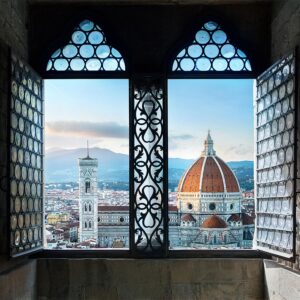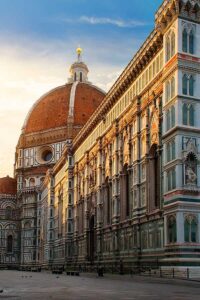Florence
Florence is a dream for anyone who loves art and history. Every person who feels to love beauty should visit it at least once in his life.
An important medieval centre, it has been an artistic, cultural, commercial and political reference point. Cradle of the Renaissance, it has witnessed the growth and passing of the vast majority of the world’s greatest artists of the time.
Florence and its history
The principal city of Tuscany and a renowned centre when it comes to art, Florence was born in an extremely favourable and panoramic position, in a basin close to the Tuscan-Emilian Apennines. It was the Etruscans, in the Villanovan era, who established the initial pile-dwellings that, on a ford of the Arno River, guaranteed the possessions of a large and fertile plain to the nascent village.
Already called Florentia in Etruscan times, an auspicious name of prosperity and flourishing that has always characterised the city, in Roman times the village was a satellite of the more famous Fæsule, but relations were reversed in the late 4th century and Florentia was elevated to Municipium and connected to Rome by the Via Cassia. Under Diocletian it became Corrector Italiae, capital of Etruria and Umbria.
After a decline during the barbarian dominations, the city developed from the 10th century to become an autonomous municipality. Despite the internal struggles between the Guelfi and Ghibellini families that characterised two centuries, the city developed enormously, becoming one of the most important centres in Europe. The result of this period was the Commedia by Dante Alighieri, the eminent Florentine whose work is known throughout the world. The decline of rival Pisa and the shrewd leadership of successive families accentuated this territorial power, until – under the leadership of the Medici family – the city became the true centre of the cultural and commercial world.
 The cradle of the Renaissance
The cradle of the Renaissance
It was then, in the middle of the 13th century, that the city attracted the world’s greatest artists and subsidised them to beautify the whole city. This era was called the Renaissance, and it was a time of enormous artistic, social, scientific, philosophical and medical discoveries.
The names that gave lustre to Florence were exceptional, and among them we can count Michelangelo Buonarroti, Raphael, Pico della Mirandola, Verrocchio, Antonio Pollaiolo, Sandro Botticelli, Galileo Galilei, Filippo Brunelleschi, Niccolò Macchiavelli and Leonardo da Vinci.
Over the centuries Florence extended and confirmed its territorial hegemony, almost always under the leadership of the Medici family. Their extinction in the mid-16th century led to the annexation of the Granducato di Toscana under the Habsburgs. After the Austrian dynasty was overwhelmed by Napoleon’s conquests, Florence decided to join the Kingdom of Sardinia by plebiscite after half a century of French rule.
For a short time the city also held the title of capital of Italy, before this was conferred on Rome after its annexation to the newly formed Kingdom of Italy.
What to see in Florence

It really is impossible to list all the places of interest in the Tuscan city, which has been a UNESCO World Heritage Site since 1982. Starting with Piazza del Duomo, which houses the imposing Church of Santa Maria del Fiore, built among others by Giotto and with the largest dome ever built by human hands, the marvellous dome by Brunelleschi and inside which you can find the frescoes by Vasari, we can then go to mention the Basilica of Santa Croce, located in the square of the same name and crossroads of the most important artists, literati, The Basilica Santa Croce, located in the square of the same name and crossroads of the most important medieval artists, men of letters, theologians and religious figures, is famous for having been chosen as the Italian national memorial by the poet Ugo Foscolo, since some of Italy’s most illustrious geniuses have found eternal rest here, or we could admire the 13th-century Church of Santa Maria Novella, whose marble façade is certainly one of the most famous legacies of the Florentine Renaissance, initiated by the genius of Leon Battista Alberti.
It is impossible not to mention the Uffizi museum complex, an artistic paradise that houses thousands of works by the most famous artists of all time, including Caravaggio, Leonardo da Vinci, Giotto, Titian, Rubens and Dürer, while opposite is the marvellous historical testimony left by the Ponte Vecchio, one of the most famous bridges in the world, which crosses the river Arno and allows visitors to enjoy one of the most unique structures in the world, where we can find – on either side of the pedestrian passageway – two rows of very old shops, with some of the best goldsmiths in the world. It is also impossible not to mention the Vasari Corridor which, passing over the Ponte Vecchio structure, joined the Palazzo Vecchio with the Palazzo Pitti, another cultural wonder not to be missed.
The wealth of historical-artistic, scientific, naturalistic and landscape heritage makes the city centre and surrounding hills a true “diffuse museum”, as the list of artistic legacies scattered around Florence make it an essential cultural centre for anyone who loves history, while the enormous number of events held throughout the year in the lily city will satisfy the palate of anyone who comes to visit, in every cultural sphere.

Villa dei Bosconi Surroundings
Fiesole
Siena
San Gimignano
Lucca
Pisa
Chianti
Our Rooms
Standard Double Rooms
Superior Double Rooms
Triple Rooms
Quadruple Rooms

